How Do You Know if Someone Is Transfering a Call Directly From a Land Line to a Cell Phone
Need to transfer a call? Y'all only have to know which buttons on your office phone (or estimator) to press. Correct?
Well actually, there's a little more to transferring a call than that—especially if you piece of work somewhere that has a business organization telephone organization (or uses softphones, or VoIP).
Not to worry though, we're here to walk you lot through the ins and outs of transferring a call. From the basic (but sometimes overlooked) etiquette involved to the actual step-by-footstep instructions, everything y'all demand to know is here.
Afterwards all, y'all want to make a good impression on your customers and make sure your phone experience reflects well on your business, right?
- The difference between telephone call transferring and telephone call forwarding
- The two main types of call transfers
- How to transfer calls to someone else
- When to use unlike telephone call transferring methods
- Business organization phone call transferring etiquette tips
- Other telephone call transfer FAQs
Get-go, let'due south become ane thing out of the fashion: call transferring and forwarding? Two unlike things.
The difference between call transferring and telephone call forwarding
Although these ii features might sound similar, they're pretty different.
During a call transfer, someone presses a transfer push button to pass an active call on to someone else before disconnecting themselves from the call. (Basically Pam'southward job from The Role.)
With call forwarding, incoming calls are automatically forwarded to a preset number without first going through a human recipient.
The two master types of call transfers
These two transfer methods are known as "warm" and "common cold" transfers. Basically, a warm transfer is when you introduce the caller to the person you're transferring them to, while a cold transfer is when you lot only put them through direct.
i. Warm transfer
The process of a warm transfer begins when you receive a phone call from someone (doesn't matter if information technology'due south through a traditional landline or cell phone).
Your conversation with this caller volition make up one's mind whether you need to pass them along to speak to someone else. If they do, so yous'd put this active call on hold.
While you have them on hold, you lot'd make a call to the intended recipient to see if they're available to take the phone call. You can as well requite this person more than data about the caller at this point. If they say yes to taking the call, then you can transfer the call to this person'due south extension number.
👉 Dialpad tip: Y'all might want to make certain your on-agree music is up to scratch while your caller waits. If you lot're using Dialpad as your phone system, y'all tin can choose from pre-recorded on-concord music (and also upload your own):
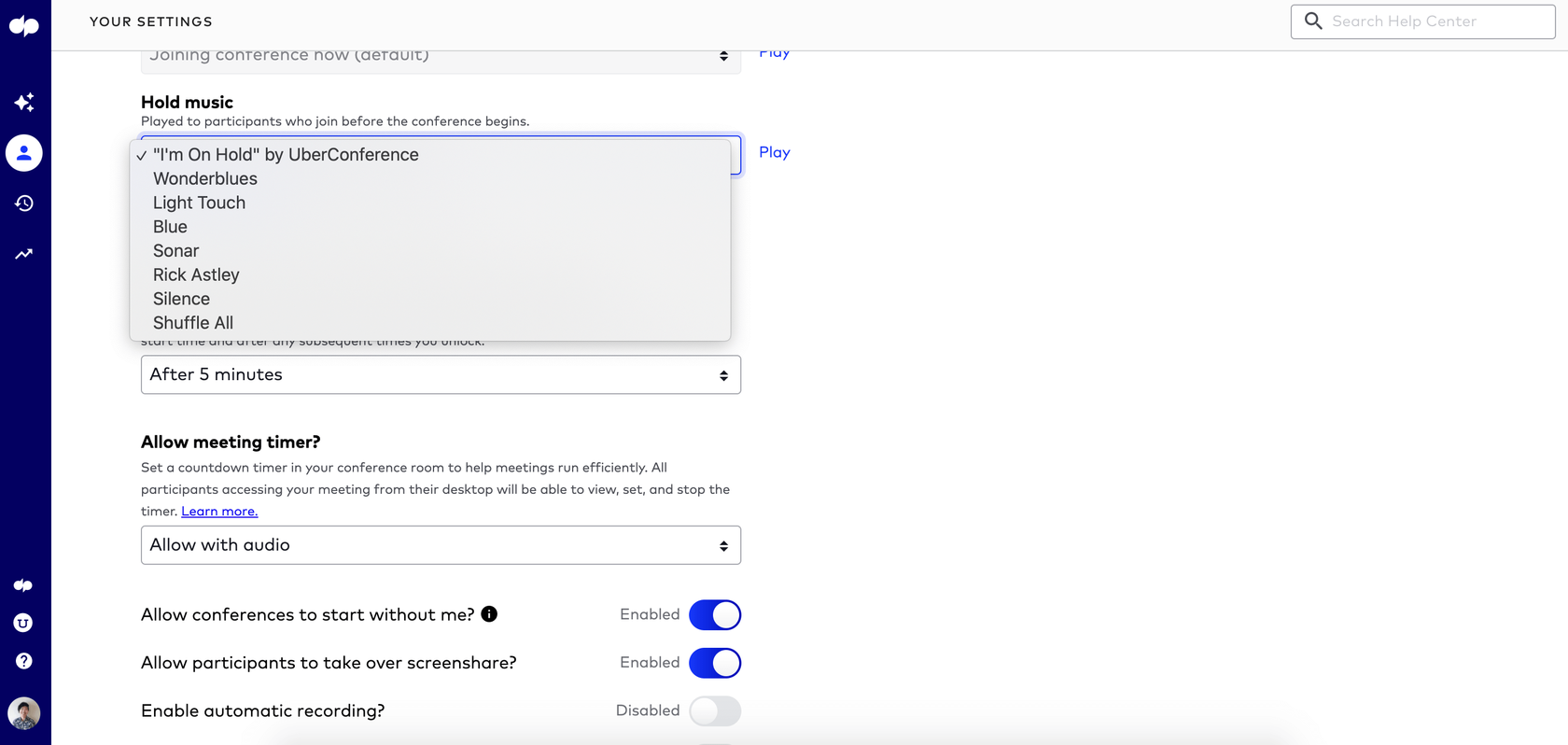
The benefit of warm transfers is that your customer doesn't have to repeat their question to multiple people—because y'all're doing it for them.
They also offer a more personalized experience, because the people you lot're transferring the phone call to would (theoretically) accept the information they need to greet the caller by their name and know a bit more virtually their consequence in advance.
2. Cold transfer
During a cold transfer, you just transfer the phone call to a colleague straight—without asking them if they're available. (You lot might besides have seen this referred to as a "blind transfer.")
The trouble for your customers is that they can cease upwardly having to echo their question to unlike people as they get transferred back and along.
Also, if the cold transfer goes to someone who can't take the phone call, your customer can find themselves confronted with the dreaded voicemail inbox. Not good for customer satisfaction.
Now, let'due south look at how to transfer calls.
How to transfer calls to someone else
Now that nosotros've looked at a few ways to transfer calls, it's time to address the question of how.
The specifics will depend on your call center direction system, but the general procedure should be similar across dissimilar platforms.
We'll utilise Dialpad as an example in this tutorial, because it makes information technology pretty piece of cake to practice. You can transfer calls seamlessly between devices, see which colleagues are available at a glance, put someone on hold, mute people on the call, and more.
Basically, you have everything you need to provide first-class customer service from anywhere. (Even if you accept a small or one-person team.)
How to carry out a cold transfer
-
In Dialpad, you lot tin but click the Transfer button while you're on a call with someone:
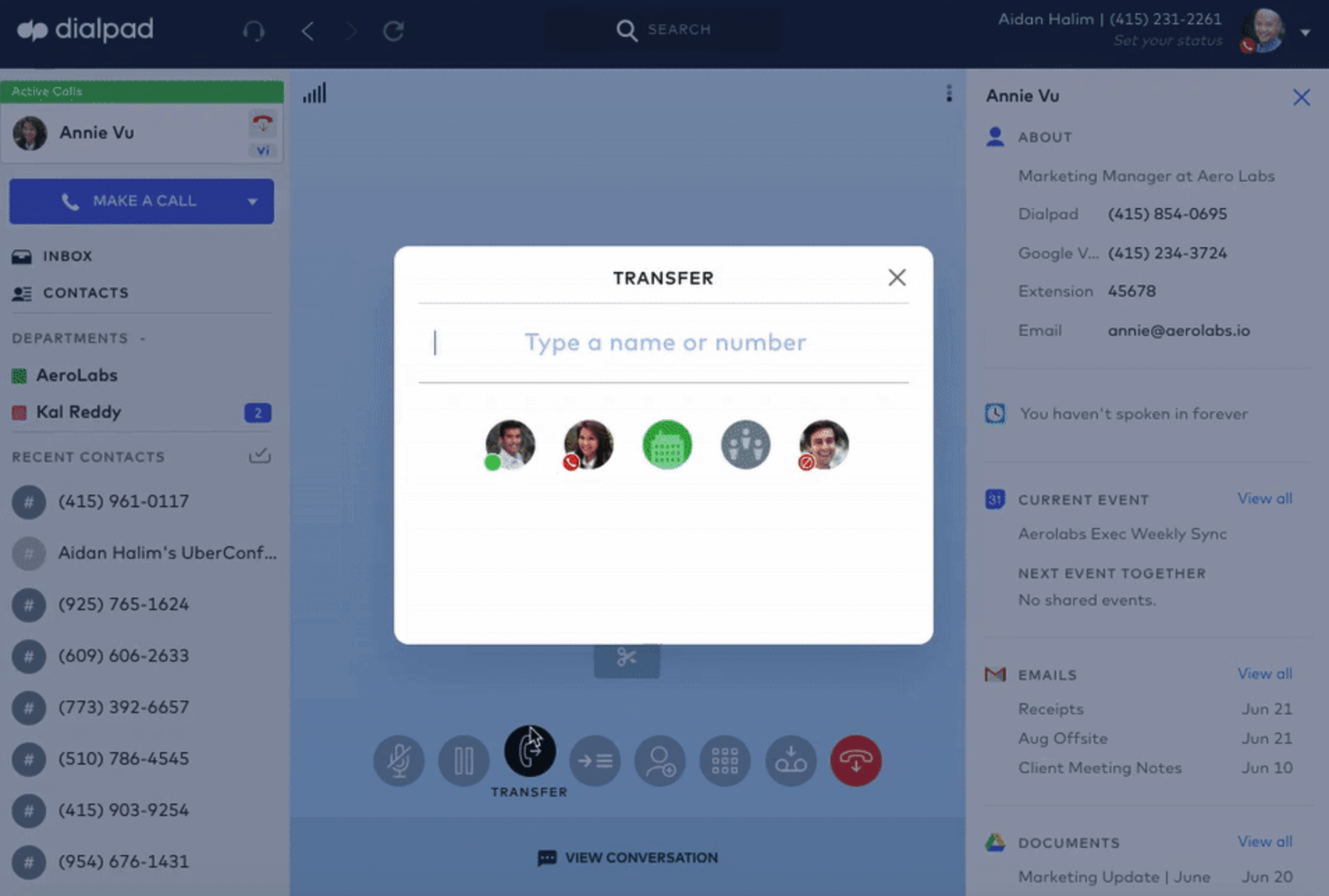
-
Search for a contact, select one of your well-nigh frequent contacts, or manually blazon in a number:
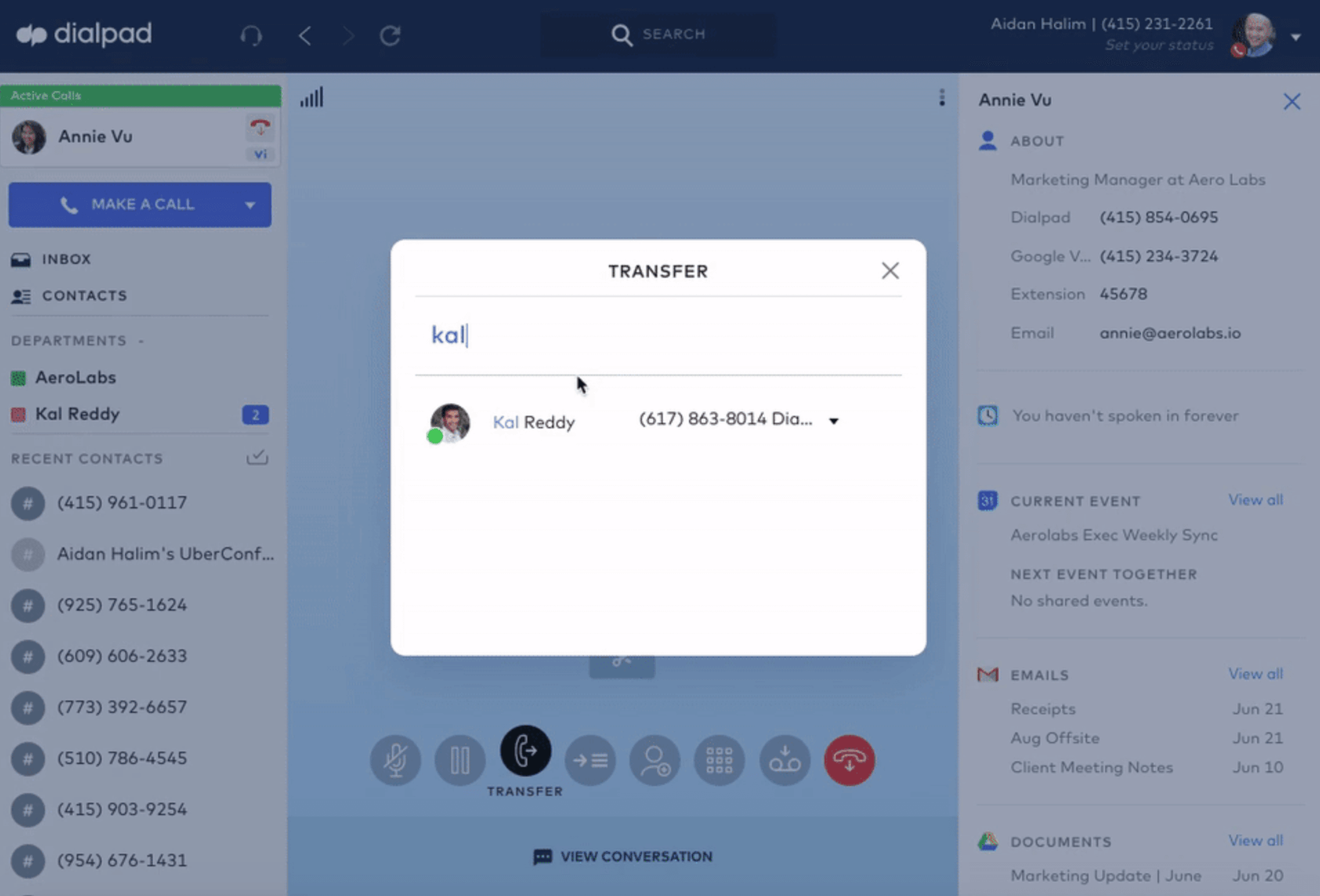
-
If a team member/department has more than one number, click on the drop-down to select the i you need.
-
Depending on who you're transferring to, your options include:
-
Transfer Now (cold)
-
Ask First (warm)
-
Transfer to Voicemail
-
Transfer to Agree Queue
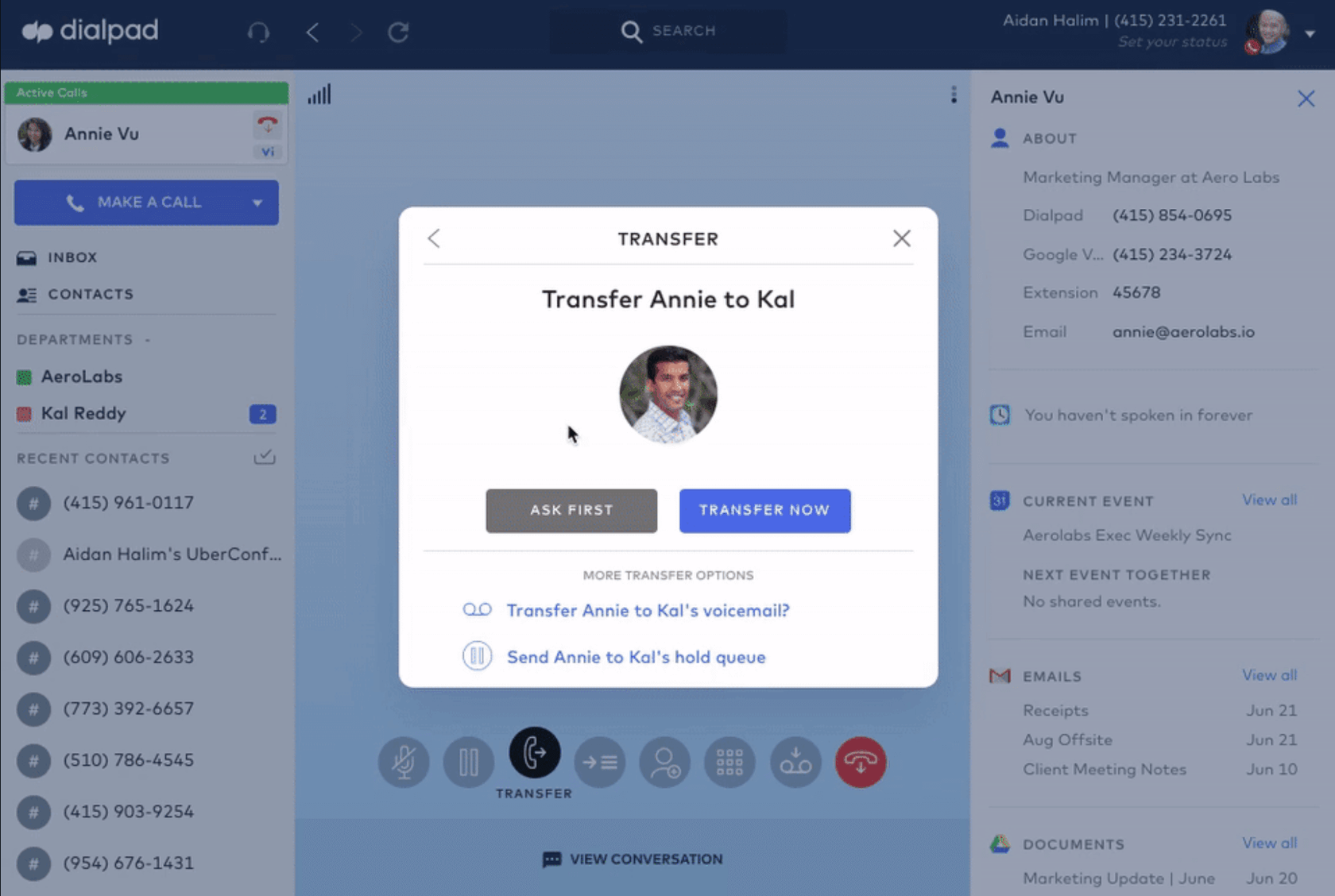
If you lot desire to do a common cold transfer, you'd hitting "Transfer Now." That's information technology!
How to practise a warm transfer
In Dialpad, a warm transfer (aka "Inquire Starting time") is available for squad members, numbers outside your organization, other departments, and telephone call centers (but they need to take a number assigned already—so that you have a number to transfer the call to).
The process is slightly different depending on whether you're using the desktop app, Android, or iOS.
Desktop app
-
Aforementioned offset step as a cold transfer—just hit "Transfer" while y'all're on a phone call.
-
This fourth dimension, instead of "Transfer now," hit "Ask starting time."
-
This volition put your active call on hold while you new call is placed to your squad member to confirm the transfer:
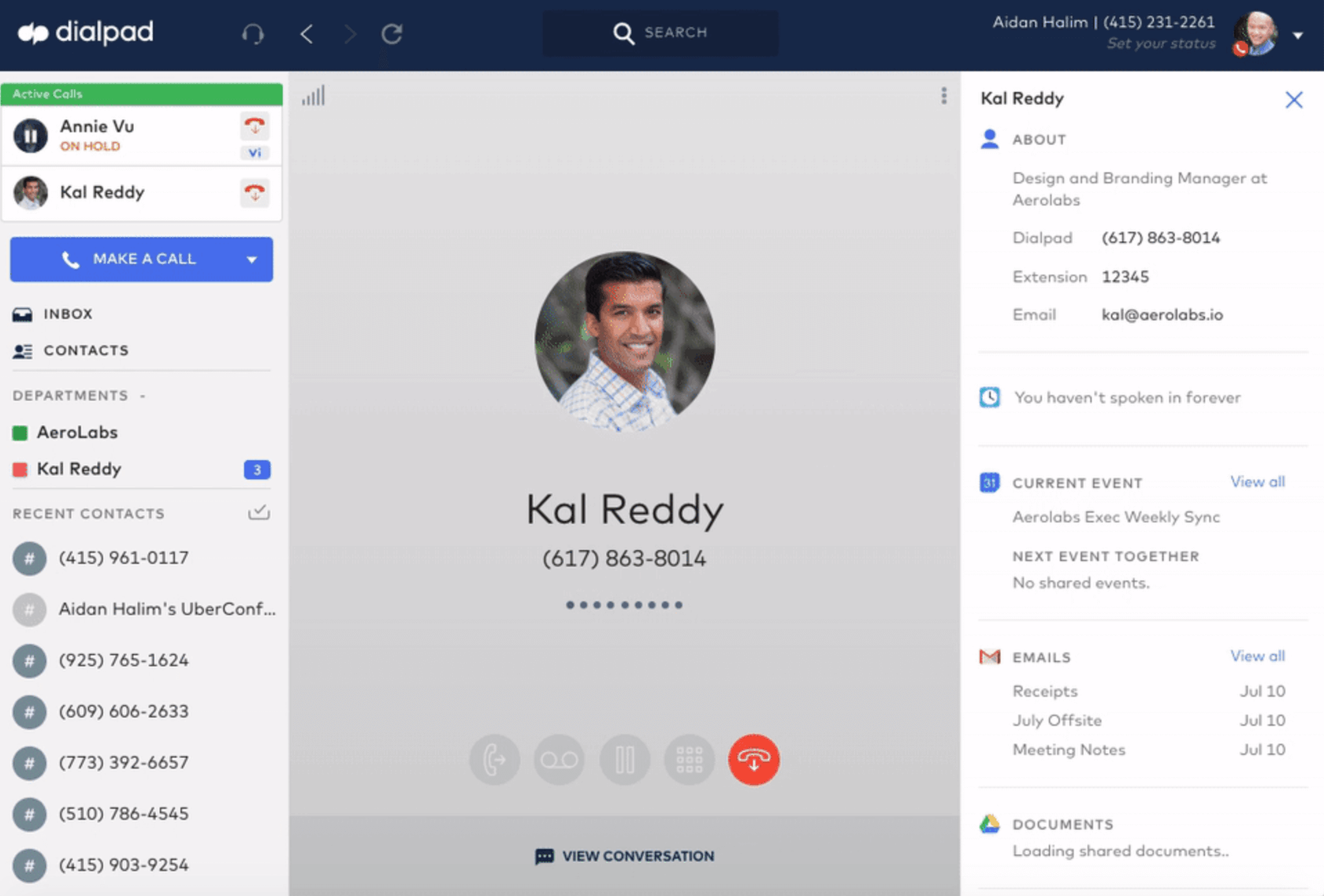
-
Once they respond, y'all can give them whatever details they'd need (meet your on-agree call in the tiptop left corner?) and ostend the transfer.
-
Set up? But hit Transfer and you lot're done!
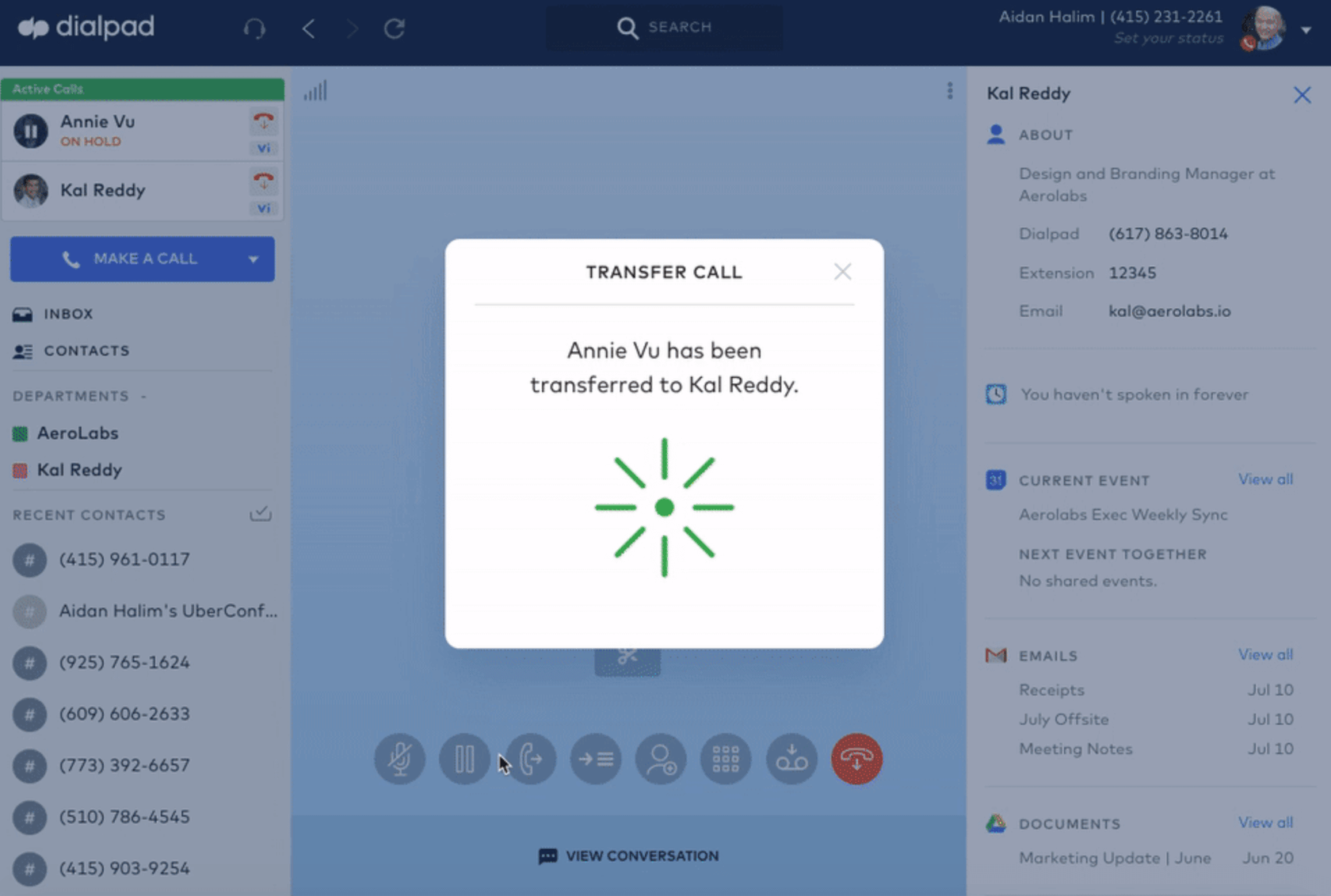
Android
To transfer a call on an Android device with the Dialpad app, it's just as easy:
-
Tap More than > Transfer caller.
-
Blazon in your recipient's name or number on your search screen
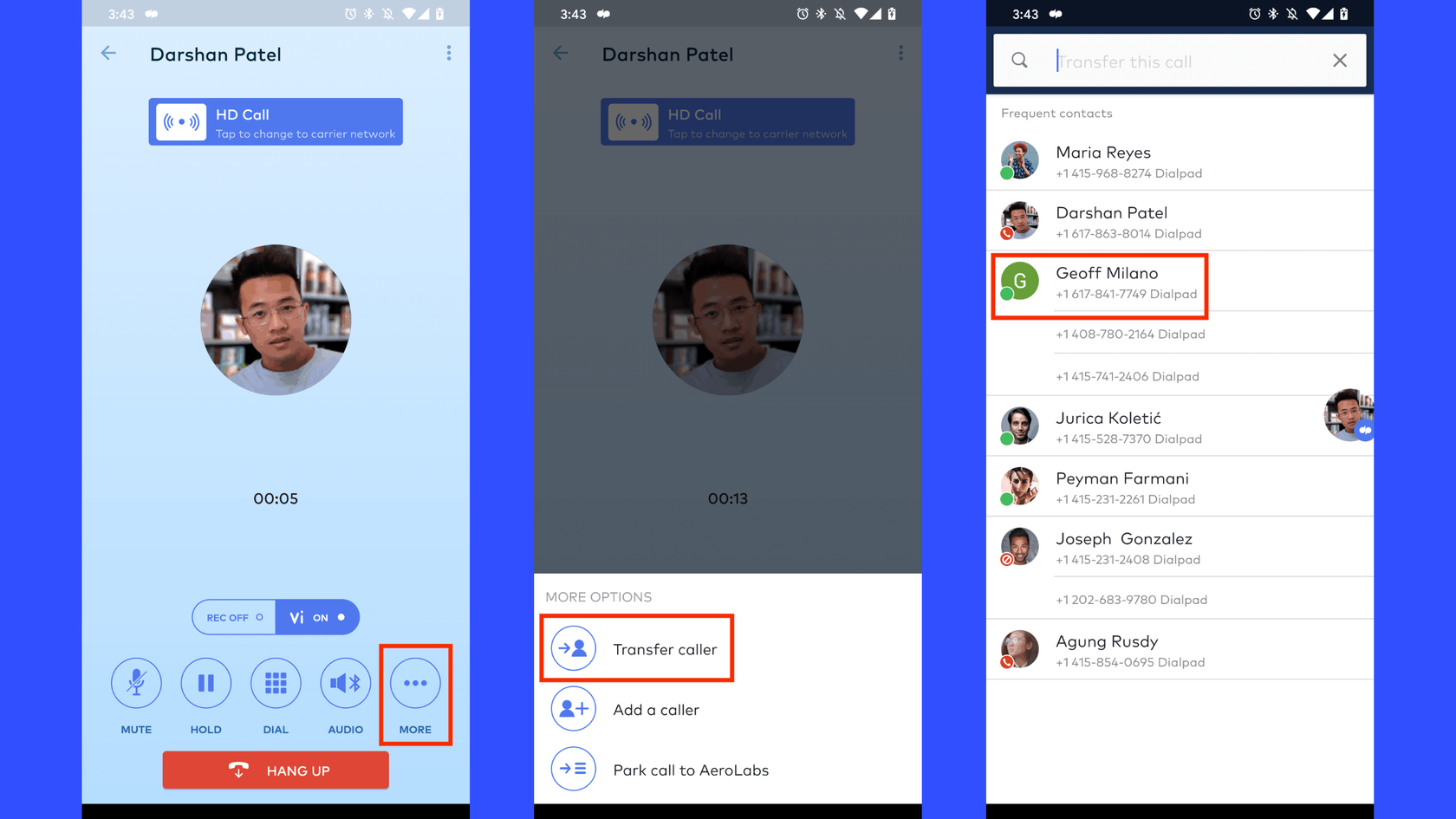
-
Select Enquire At present.
-
Your current call will at present exist placed on hold as the new call is made.
-
Once the new phone call connects, yous'ved transferred the call!
iOS
If you're using an iOS device and desire to transfer a call:
-
Tap More than > Transfer caller.
-
Type in your recipient'southward proper name or number on your search screen

-
Select Inquire Now.
-
Your electric current call is now put on hold as the new call is fabricated.
-
Select transfer in one case the new telephone call connects.
When to use different phone call transferring methods
Okay, y'all're a pro now at both warm and cold transfers—and so when would each come in handy?
1. When no context is needed (straight transfer!)
This is the almost straightforward selection. But it's merely suitable when it isn't necessary to provide whatever background information before the caller talks to whoever they're being transferred to.
The other event with this is you take no manner of knowing if the 2d party is available to take the call.
Despite these disadvantages, direct transfers do still have their identify. For instance, your caller may need to speak to a unlike department entirely and wouldn't benefit from a short introduction from you.
(Maybe in that location's just besides much information for you to provide to someone anyway or there's sensitive information that they should requite that person themselves.)
👉 Dialpad tip: Before doing a cold transfer, consider whether the destination department is well-staffed to respond calls and whether they have voicemail set upwards. Otherwise, your caller volition reach a dead end and have to start their call all once more...
ii. Depression phone call volumes (Ask first)
Every bit nosotros mentioned above, this has multiple benefits, including prepping your colleague in advance and freeing your caller of the annoying job of having to repeat themselves.
If you work in customer support, transferring a call in this mode can boost your phone call center productivity—saving time by preventing repeat calls from people who weren't transferred successfully.
3. The fallback choice (Send to the 2nd political party'southward voicemail)
If neither of the outset two options works for you lot, it'south possible to send calls to someone's voicemail. This might exist useful when you lot know that your caller has to reach that specific person, and yous besides know that person is unavailable (perchance they're on vacation).
This option volition put your current call on hold, merely like with a direct transfer. But in this instance, the call will then exist direct transferred to that person'south voicemail. Your caller can then leave a message for the person they need to speak to before hanging upwards.
👉 Dialpad tip: Make certain that everyone in your team keeps their voicemail greeting up to date!
Concern phone call transferring etiquette tips
When information technology comes to business telephone call transferring, at that place's a certain etiquette involved. Transferring a call is nigh so much more than having your colleague on speed dial. It's all about making a good impression on your caller as they're hanging on in there to discover a solution to their trouble.
Quite often, a phone call will be a potential customer's first point of contact with a business organisation, so it pays to get this right. If they hang upward feeling dissatisfied, it's all likewise piece of cake for them to just pick the phone support to call one of your competitors.
Beneath, we'll share five quick contact center tips for call transferring etiquette. One tip: include these along with other essential data in your team's training materials. Everybody should know how to transfer a call correctly, from your managing director right downwards to new contact heart reps.
one. Provide and obtain data before transferring
Imagine: You've received a call and tried to transfer it without taking your caller'southward details or providing your name and extension number. In the unlikely event of yous becoming disconnected, this could exist a problem. The caller would have to start the call from scratch and would be (understandably) frustrated.
Every bit a all-time exercise, give your caller the proper name and extension number of the person you're transferring them to.
two. Don't forget to explain why you are making a transfer
If you lot demand to transfer a call for whatever reason, you lot should always explicate why. It could exist that your caller has simply reached the incorrect person or department. Possibly you lot don't accept the correct knowledge or proper say-so to answer their query satisfactorily.
Whatever the reason, it's always helpful (and polite) to keep your caller in the loop.
3. Ask permission before you transfer your current call
Don't assume that you automatically accept the correct to transfer callers. When you ask for permission to initiate the transfer, this gives them the opportunity to ask any other questions they might have. (This also gives them a chance to say they'll just call back another time if they're on a tight schedule.)
If a caller refuses to give permission to be transferred, make sure that you understand why. To encourage the transfer and your customer's journey to continue further, you tin attempt explaining that information technology's the fastest and most effective way for them to receive assistance.
You could too try clarifying that y'all will make full in the 2d party on their behalf and then they won't accept to explain themselves all over again.
iv. Wait for the 2d political party to pick up
If your caller expects to be put through to someone who has been fully briefed most their consequence, it would be rude to only transfer the telephone call cold.
Not to mention it's unfair to unleash a dissatisfied customer on a colleague without giving them the risk to prepare mentally. You should share your valuable insights about the call with your colleague and and so make your introduction.
Information technology almost sounds a chip like friction match-making, doesn't it? Hopefully, this will be the beginning of a profitable business concern relationship...
5. The perfect ending
Once you've returned to your caller and confirmed the name of the person or department yous're transferring them to, it's time to complete the transfer. Call up to thank the caller for their patience and ask if there's annihilation else y'all can do to assist earlier yous transfer them.
After you've completed the transfer by connecting your caller to the second party, it'south crucial to retrieve well-nigh how y'all stop the call. Always strive to practice this politely and professionally. Make sure you're up to appointment with company policy when it comes to dealing with hard callers.
Other telephone call transfer FAQs
What are call transfers exactly?
A phone call transfer is the process of sending incoming calls to other people (or voicemail). You usually practice this either with a dedicated transfer push on a concrete phone or by using your phone system software. You've probably been on a few phone call transfers yourself when y'all tried to get in touch with companies.
Does my company need to be able to transfer calls?
Pretty much any company that relies on phones to provide customer service will demand to transfer calls. In that location can be many reasons for this. Perhaps your company is receiving a large volume of calls and needs to get multiple departments involved to field them all.
Information technology might exist simply that your customer needs to speak to someone from a different department or someone with a different knowledge base.
To make a transfer, you generally need to include the original caller's phone number or other identifying data. More sophisticated business phone systems will likewise pull upwardly additional information for you or your colleagues, like notes by previous call handlers.
👉 Dialpad tip: Did you know that Dialpad's Telephone call Summary captures all the critical information on a call for y'all? Its Vocalism Intelligence (Vi) engineering transcribes your calls (more accurately than Google), creates reminders of follow-up items, and more—all without y'all lifting a finger.
Tin can I troubleshoot call transfers on my own?
If y'all have any problems with transferring calls, it should be easy to fix on your own.
(Although this depends, of class, on your phone or contact center platform. Some are easier to employ than others.)
Some service providers take great client back up and assist functions available. For case, Dialpad has 24/7 customer back up—and not just in the United states of america—in addition to a comprehensive Help Heart so that you can get answers anytime, anywhere.
What are the most common call transfer problems?
One of the main causes of disconnection is when callers try to create a loop. This means that you're trying to transfer the call back to someone who originally transferred it. This would make the call drop.
Another rule of thumb is to bank check that all your equipment is functioning and up to date. Some telephone systems only back up certain desk-bound phones and handsets. (You can notice a list of Dialpad'southward supported IP desk phones hither.)
And sometimes... call disconnection tin simply be caused by human error. Maybe your caller hung up by blow. It's not always your fault!
Who cares most telephone call transfers? What are the benefits anyway?
Call transferring offers many benefits for both large and modest businesses alike. Here are the three big ones.
one. It makes life easier for distributed teams
Call transferring allows teams to piece of work from anywhere—while providing full back up for customers and colleagues. When you transfer a customer to a colleague, the caller has no way of knowing if they're in the function next door to you or somewhere else entirely.
This means that you lot tin accept calls from habitation equally usual—merely like if you were physically in the role.
2. It smooths out the edges of your customer service
We don't have to tell yous how important good client service is. Today's customers expect a personalized and integrated experience—and that includes non having to echo their questions on the phone to v different people.
That's why having a warm transfer feature like Dialpad's Ask First characteristic is central. It but makes for a smoother customer experience (that doesn't make them piece of work every bit hard to communicate with you).
3. It gives your business a more professional person image
Whether you're a small squad—or if you're the only person on the team—being able to transfer phone calls competently is one of the almost professional person things you lot can do in terms of the customer experience on the phone.
Particularly if your team works remotely! Let's say you receive a telephone call for a colleague who's working from home. With Dialpad, information technology's easy to toggle to this colleague'south prison cell phone number and put the phone call through. The caller is none the wiser. As far equally they're concerned, the transfer could've just been made to the office next door.
Without a business telephone system, your only selection would exist to requite out a personal phone number. It's not every bit professional person—and opens up your team to after-hours calls on their personal phones.
Go along these top tips in mind when telephone call transferring
Call transferring systems are like knights in shining armor for phone call centers. (And many other customer service functions!)
Each time your phone rings, that's an opportunity to give your caller or customer an amazing experience. And call transfers are a simple—and inexpensive—way to provide better service on the phone. Doing these seemingly piddling things well, and doing them consistently, will go a long manner in helping you build your make and grow the business.
Who knew that something as simple as transferring a call the correct way could practice all that?
crothersnuied1997.blogspot.com
Source: https://www.dialpad.com/blog/how-to-transfer-a-call/
0 Response to "How Do You Know if Someone Is Transfering a Call Directly From a Land Line to a Cell Phone"
Postar um comentário